Saber (Sabre, UK Spelling))

|
[Military Equipage] A saber is a single-edged, curved sword generally carried by cavalry. It is used as a slashing weapon those wound hopefully will disable the opponent and remove him from the fight. The upper body is generality the target and the curve allows it to glide off the target in a smoother way than would a straight sword as the rider moves away from his target. Sabers were not commonly used against the horse. With the advent of modern firearms sabers had more of a ceremonial than practical role.
Sack Out
[Training] Sacking out a horse is a process in which a green horse is carefully introduced to the various pieces of equipment that will be used around him, such as saddle pads, lounge lines, etc. The trainer speaks works of encouragement and rubs the various items against the horses body. In prior times harsh measures were used to achieve the same goals, but they have been abandoned.
Sacroiliac Subluxation (Hunter's Bump)
[Veterinary Medicine] Sacroiliac subluxation is an abnormal slippage at the junction of the spine and the sacrum of the pelvis. It appears as a visible bump forward of the croup. It is felt to be the outcome of multiple minor injuries causing laxity in the supporting ligaments. It is more common in racing and competition horses. The condition leads to muscle soreness and stiffness. Treatment is rest, steroid injections, anti-inflammatory medications, and manual manipulation by a veterinarian to correct the position of the sacrum. Full recovery is possible.
Sabino Gene
[Equine Genetics] The Sabino 1 (SB1) gene is found in many different horse breeds and is responsible for patterns of prominent white markings on their coats. When the Sabino gene is in play the markings tend to have roaning at the edges and are more irregular and expensive than non-Sabino gene involved white markings. White markings in some breeds, such as Arabs, Thoroughbreds, Standardbreds and Clydesdales, are not mediated by the presence of a Sabino gene. On the other hand, American Paint Horses color patterns are dependent on the presence of the gene. When two copies of the gene are present (homozygous horses) the markings are much more extensive. It is possible to test for the presence of the gene.
Sacrifice Pasture (Exercise or Loafing Lot)
[Horse Management] A sacrifice pasture is a small paddock that is reserved for use during periods when main pastures are overgrazed, muddy, or require maintenance, often in the wintertime. They are sacrificed in order to protect the main pastures from damage. You do not go to a lot of trouble to maintain the sacrifice pasture but I try to maintain good drainage at least, so that it is not too muddy. I also use them as a holding area when the vet or farrier is coming.
Saddle
[Equine Equipage] A saddle is a device fitted to a horse's back that provides a seat for a rider. Think of a saddle as a coupling device that needs to fit both parties. While it is possible to ride a horse bareback without a saddle, both parties benefit if the saddle fits properly. The use of saddles in riding first appeared among the Scythians as a military innovation during the 4th century B.C.E. Prior to that horses were ridden bareback or with animal skins or blankets as padding. Early riders must have been heavily muscled.
Saddlebred (American Saddlebred)
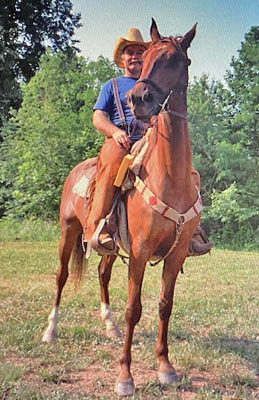
|
[Horse Breed] American Saddlebreds are 5-gaited riding horses developed at antebellum Kentucky plantations. They have finely formed heads, arched necks and high carried tails. Their additional gaits, which are trained and not natural or innate to the bred, are a two four-beat ambling gait, called the slow gait, and the ever-popular rack, a faster four-beat gait.. In older sources the breed was called the American Saddle Horse but that name was felt to be too generic and replaced. Many consider them the most beautiful of the show horse breeds in form and motion.
Saddle Cloth (Saddle Pad)
[Horse Equipage] A cloth pad placed between the horse and the saddle. It provides extra padding to protect the horse from abrasion from the saddle and absorbs sweat from the horses coat. Saddle pads often, but not necessarily, have means of securing them to the girth and the saddle.
Saddle Fitter
[Equine Professional] A saddle fitter evaluates the horse and rider and optimizes the fit of the saddle to both. They may advise on the purchase and fit of a new saddle or modify the fit of an existing saddle. Some saddles are built with adjustable features and wool padding called flocking, which is inside the saddle, can be modified. The geometry of a horse's back will change in time as the horse grows or ages. Likewise the rider may evolve in different seat or experience a redistribution of weight. Think of a saddle as a coupling device that needs to fit both parties.
Saddle Fittings
[Equestrian Equipage] Saddle fittings are those accessories that are used with the saddle in order to ride. The basic fittings are the girth that holds the saddle on the horse, leathers that connect the stirrup to the saddle and stirrups that support the rider's feet.
Saddle Mark
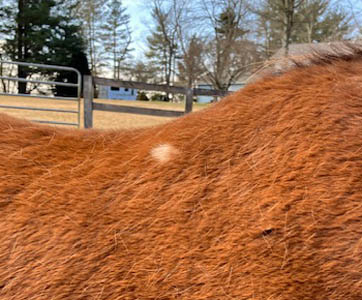
|
[Veterinary Medicine] A saddle mark is a patch of white hair that grows in an area where there was once a saddle sore.
Saddlery
[Equine Equipage] A saddlery describes the the trade, articles of trade, or shop of a saddler, someone who makes, repairs, or deals in the articles used to ride a horse.
Saddle Sores
[Veterinary Medicine] Saddle sores are pressure sores seen in horses over areas of abrasion from tack, often ill-fitting tack. They also can be found in horses that are wearing harnesses that rub. Sore areas can progress to secondary bacterial infection and should be taken seriously. Once noticed the horse should be allowed to heal before any tack is again used.
Saddle Strings
[Equine Equipage] Saddle strings are small rawhide strings suspended from the side of a western saddle. They were used to lash equipment but now are mostly decorative.
Saddle Tree
[Saddle Terminology] The saddle tree is the frame that gives the saddle its shape and strength. Traditional ones were made of wood and then covered with padding and leather. Modern ones can use various materials. Trees are formed to allow for the horse's spine and distribute weight away from it.
Sable Island Horse
[Equine Breed] Sable Island horses are native to remote Sable Island, which is located of the coast of Nova Scotia, Canada. The herd was originally deliberately marooned on the island. Since the 1760s they have evolved into a small, hardy, shaggy pony-sized, feral animal, processing natural ambling gait and short limbs. The population is now fully protected by the Canadian government.
Salt Block
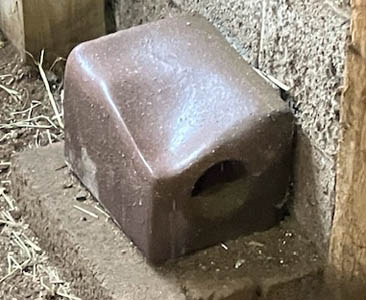
|
[Equine Management] Blocks of salt are provided horses which contain sodium chloride and various essential trace elements: zinc, iron, manganese, copper, iodine, and cobalt. Particularly in warm weather you will notice horses licking them.
Salute
[Dressage] At the end of a dressage test the rider brings their horse to a halt, facing the judges. The rider then salutes the judges by placing the reins in one hand (which is also holding any crop), lowering the other arm to the side and nodding their head to the judge. The judge then nods in return. It is all very civilized and all very formal, but I can only think that referees and judges in other competitive sports are envious of the respect shown dressage judges.
Sand Colic
[Veterinary Medicine] When horses are fed on a sandy surface they can ingest enough sand for it to cause colic in their intestines. The symptoms are those of other types of colic. Treatment is hydration and giving laxatives. Prevention includes some type of raised feeder so that they are not feeding on the ground. Severe cases can be fatal, particularly in young horses.
Sand Crack
[Veterinary Medicine] A sand crack is a thin superficial crack in the hoof wall that begins at the coronary band and move downward. It is caused by trauma and environmental stresses.
Sandwich Case
[Fox Chasing] A sandwich case is a leather box designed to hold a sandwich, while out chasing. They are held by three straps, two connecting to the saddle by dee rings and one running forward and looped around a billet strap. They are also carried in formal attire horse show classes, in which case they need to have a sandwich of the prescribed type and have the crust trimmed off.
Sawbuck (Crossbuck)
[Equine Equipage] A sawbuck is a wooden rig and saddle, used to attach packs to a pack animal. It is used with an extra-thick pad and is double-rigged (held by two girths.)
School Canter
[Dressage] A school canter is a slow, long stride canter that is fairly difficult to train a horse to do. It is just a little faster that a walk, but preserves a great deal of impulsion.
Schooling Show
[Horse Show Type] A schooling show is an unrecognized horse show conducted for the purpose of introducing young riders to showing. They are often sponsored by riding stables or riding clubs. The novice riders particularly enjoy collecting the ribbons for their efforts.
Scope
[Jumping] A horse's scope is their athletic abilities to jump long and high.
Scratch
[Equine Competition] A horse that is removed from a list of competitors is said to have been scratched. With each type of competition there are set rules and requirements governing scratches.
Scratches (Pastern Dermatitis)
[Veterinary Medicine] Scratches are a topical infection of the lower legs, often associated with muddy conditions. The microbiology is of mixed flora, but bacteria may be the major contributor. It is characterized by scabs, hair loss and bumps on the pasterns and fetlocks. Treatment measures include rotating horses to higher ground and away from any wet or muddy areas, removing mud with a stiff brush, drying the lower legs when moisture has built up, antibacterial shampoos and zinc oxide. When the horse has major involvement trying to aggressively clean the area may produce additional trauma. Mild cases often will improve with a change in the weather. For major cases a vet should be called in.
Scissors
[Vaulting] The scissors is a vaulting compulsory competition move in which the rider swings her legs back and then flips over, so as to be facing the back of the horse all while moving and while holding on to the surcingle grips..
Scrim
[Equine Equipage] A scrim is a lightweight fine mesh sheet used in warm weather to keep flies off a horse's body.
Scurf (Also Scarf, Equine Cannon Keratosis, Pastern Dermatitis and Dandruff)
[Veterinary Medicine] Scurf is a group similarly-appearing dermatological conditions characterized by a patches of dry, flaky, scaly or encrusted skin. They can be associated with hair loss. Treatments include shampooing with medicated soaps.
Season (In Season or Heat)
[Equine Physiology] A mare is said to be in season during the part of the estrus cycle when she is sexually receptive (in heat).
Seat
[Attribute of a Rider] The term seat refers to a rider's position or posture in the saddle. There are various styles of seats for various functions or styles of riding. There are three principle seat positions in English riding. They are the forward (jumping or hunter) seat, the commonly used light seat and the slightly backwards equitation (dressage) seat. However, it is always true that a good seat should be balanced and at the same time the rider relaxed. Some people seem to have a naturally good seat even when they are inexperienced riders. I always admire a rider with a good seat and a certain presence in the saddle. It is hard to describe but I know it when I see it.
Seat
[Saddle Terminology] That part of a saddle in which the rider sits. The term is also used to describe the manner or position in which the rider sits in the saddle (see above).
Secretary
[Horse Show Official] A secretary is responsible for signing in participants, collecting entry fees and producing a record of results at horse shows..
Seedy Toe
[Veterinary Medicine] Seedy toe (dystrophia ungulae, or white line disease) is a condition of the inner hoof wall in which it becomes soft and loses horn substance. There is a separation of the hoof wall and the laminae. Wet environments and invasion by bacteria and fungi play a causal role. It is treatable and generally has a good prognosis if not far advanced. It can form cavities and cracks in the hoof.
Seeing a Stride
[Jumping] Seeing a stride refers to the calculation a jumper must made as to the distance between to jumps and the optimum number of strides necessary to reach the point where the jump is made. Those jumping walk the course prior to competing and do not make these calculations of the fly. I remember my wife once had trailer loading problems and arrived just in time to do a horse show jumping class she was totally unfamiliar with. She managed to complete the course on the fly but not in the correct order. I have also seen a professional complete a course by the grace of God when his reins broke in the middle of the course. Advanced jumping competitions are challenging and dangerous. Seeing the stride correctly from the outset and then maintaining a good rhythmic approach to the jump are critical for the safety and both horse and rider and the success of the jump.
Self Carriage (Body Carriage)
[Dressage] Self carriage is the ability of a dressage horse to carry itself with a desirable posture (neck arched, good suspension, light, fluid leg movements, hindquarters engaged, etc.) and without the rider needing to rely on the use of aides to achieve the result. This allows for the rider to concentrate on cueing movements of the dressage test without needing to be concerned about also adjusting the horse's posture. It is one of the reasons an experienced horse and rider seem to be using little or no aides during a dressage test. What is not so oblivious to the casual observer is all the work undertaken to achieve this.
Selle Franšais (in English French Seat or Saddle)
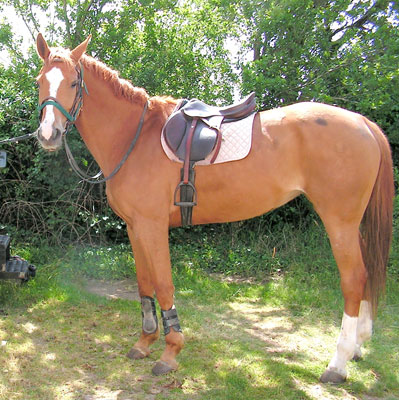
|
[Equine Breed] Selle Franšais horses are a fairly modern breed that was developed in France as a sport horse. There are no set breed standards for Selle Franšais because of the varied breeds they were developed from. They are generally bay or chestnut in color, tall and athletic with a broad head, long neck and straight back, powerful hindquarters, and hard hooves.
Serpentine Movements
[Schooling] Serpentine movements are ones in which the horse makes a series of turns, first one way and then the other in an "S" pattern or of snake-like appearance. The movements could be around poles or just in an open field. They help create "suppleness" of movement in the horse and responsiveness to the rider's aids.
Sesamoid Fractures
[Veterinary Medicine] Sesamoid bones naturally occur, imbedded in tendons at various locations in a horse's leg. Their function involves reinforcing the tendon at glide points and they are subject to shear forces. The particular sesamoid bone location and the nature of its injury is important, but beyond this simple definition. Various treatments are available. Humans also have sesamoid bones and the largest and most obvious is the knee cap.
Set Back
[Equine Behavioral Problem] A horse that sets back repeatedly pulls back against any lead rope that is securing him.
Shadbelly
[Equestrian Wear] A shadbelly is the tern given a formal riding tail coat that goes to the waist in the front and has tails in the back. It is worn in higher level dressage and hunter classes. A light colored vest is worn under it and high-waisted breeches that are white or for hunters buff or canary.
Shadow Roll
[Equine Equipage] A shadow rolls is a piece of sheepskin worn over the horse's nose to block distracting shadows on the ground from the horse's sight.
Shank
[Equine Equipage-Curb Bits] The shank on a curb bit is the part of the frame of the bit between the mouthpiece and the rein attachment
Shank (Lead Shank-Head Collar Rope-British Usage)
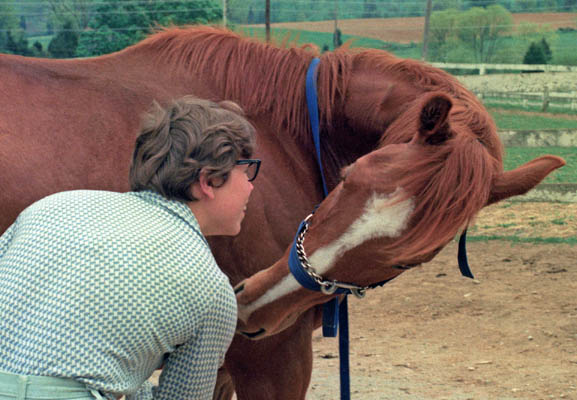
|
[Equine Equipage-Leads] A lead shank is length of rope or a leather or nylon strap with a clip at the end that attaches to a horse's halter. The lead is used to hold or lead the horse or to secure it when tied. Some shanks have a section of chain set before the clip that can be passed over the horse's muzzle for greater control.
Shetland Pony
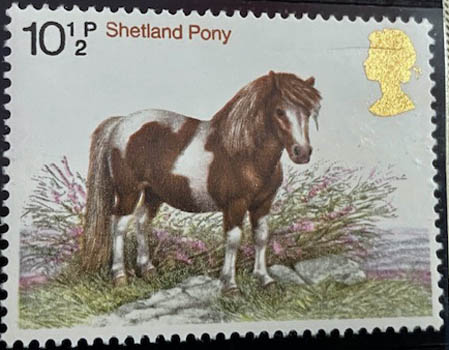
|
[Equine Breed] A pony breed native to the Shetland Islands. For their size Shetlands are the strongest of all breeds and in former times were employed in mines. They have long manes and tails and a dense double winter coat, like other cold adapted breeds. They are considered relatively intelligent. Being originally native to an island with harsh conditions they are easy keepers and hardy but at the same time susceptible to founder if on rich pasture.
Sheading Blades
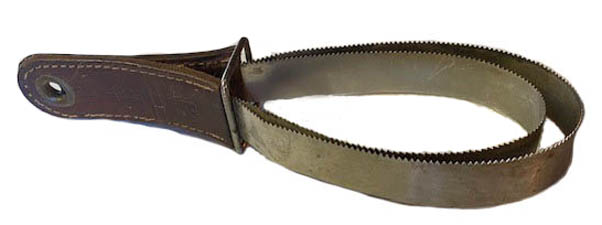
|
[Horse Grooming Tool] In late winter and into spring, it is necessary to remove the excess molt hair from the coat. Failure to do this results in a layer of hair coating saddles, saddle pads, other tack and last but not least the rider, himself. There are several types of single edge toothed blades that are commonly used. I use two different kinds. One is the double band blade type. This has two handles and two blades which can be used either folded together or extended in an open position. This type works well over large open areas of the body. The other type that I use features a single handle from which two circular blades extend. It works well is smaller curved areas, where it is hard to configure the band type blades to fit.
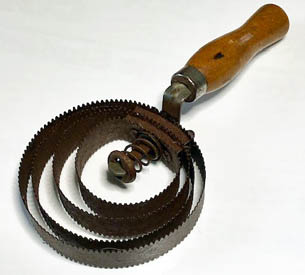
|
Sheading Process
[Horse Physiology] Hair bearing mammals, including humans, have a base line, phased sheading of hair. This is in balance in phases. The active phase in which hair is growing is know as the catagen and the resting phase known as telogen. A molt is when the a large number of hairs are shed on top of base line loss. Because hair provides horses with protection against winter's cold, in North America they begin sheading their winter coat in late January and early February. The onset is governed by seasonal changes in light day and not temperature as such. Normal sheading is impacted by certain disease states, such as Cushing's disease.
Sheath (Foreskin)
[Equine Anatomy] The sheath of male horse is skin that folds over the penis. It must periodically be cleaned and may develop hard concretions know as beans.
Shipping Boots
[Equine Equipage] Shipping boots are padded, fitted guards worn over the horse's lower legs while trailering. They attach via Velcro strips. They are not true boots in the sense that they stop at the hoof.
Shipping Fever
[Veterinary Medicine] Shipping fever is any febrile illness experienced by a horse during or just after being transported. Horses, much like people, are stressed by travel. Although there is an extensive differential, the most common cause of shipping fever is a bacterial pneumonia. Preventative measures include limiting travel to 100 miles or less and restricting dust in the travel environment. The prognosis is better if the illness is caught early and horse's temperature should be monitored twice a day during travel.Shire Horse
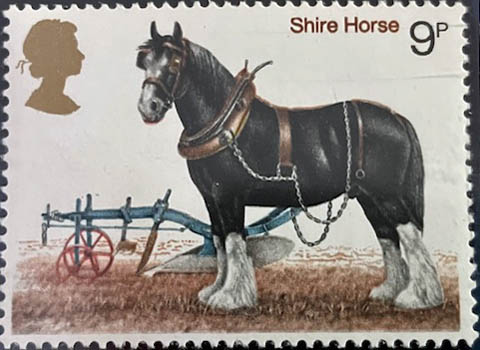
|
[Horse Breed] Shires are a particularly large English breed of draft horses. They descend from large horses originally breed to carry the weight of a knight in full battle armor. In more recent times they pulled heavy wagons and did other draft work. Perhaps the largest draft horse ever recorded was a Shire, standing 21.25 hands and weighting 3360 pounds.
Shoe Puller
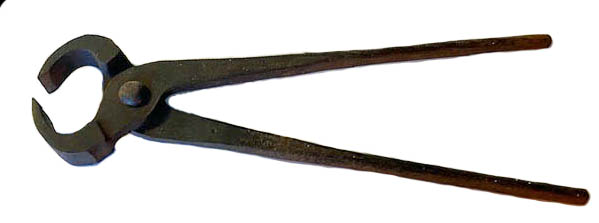
|
[Farrier Equipment] A shoe puller is an iron tool designed to pull a shoe shoe off of a hoof by sliding between the hoof and the shoe and prying the shoe off.
Short-Coupled
[Equine Body Type] Short-coupled refers to a horse with a shorter back that typical of other horses. Certain breeds are characteristically short-coupled, such as the Arabian, which are actually missing a vertebral segment. Many riders prefer short-coupled horses with the idea they are more maneuverable and quick during show jumping. Thoroughbreds, on the other hand, tend to be long-coupled with longer strides better for racing. Short-coupled horses are generally believed to be much more successful in bucking their riders off than long-coupled ones. They may be less likely to suffer soft tissue back trauma.
Short Format Eventing
[Equestrian Competition] Short format eventing is a modified eventing competition from which certain phases have been eliminated. The short format retains dressage, cross country, and show jumping tests. The majority of eventing competitions are now done in short format. The 2004 Olympic Summer Games in Athens was the first to introduce the short format in Olympic competition. Many other competitions followed. Short format removed steeplechase (phase B) and roads and tracks (phases A and C) from the competition. Cost, manpower, and land requirements were cited as the reason for the change.
Short Pastern Bone (Coronet Bone)
[Equine Anatomy] The short pastern bone is located below long pastern bone and above coffin bone in the horse's leg. It is one of the bones that makes up the coffin joint in the hoof. About one-half of the short pastern is located with in the hoof.
Short Stirrup
[Hunter Jumper Competitions] Short stirrup classes are for for novice riders who have not competed over fences at a height over 2 feet yet. Typically they had an age limit of under 11 years old. I should point out that the stirrup leathers are the appropriate length for the rider's height. It is just those riders completing are young and not particularly tall.
Shoulder-In
[Dressage] A horse doing a shoulder-in is going forward, often at a trot, with the forequarters bent toward the inside and the hindquarters square to the track of the movement. In dressage it is a basic lateral exercise that helps develop strength and suppleness.
Show Bows
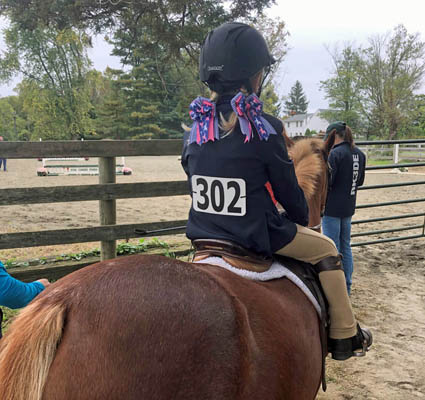
|
[Girls Riding Accessory] Show bows are hair ribbons that young female riders wear to complement their outfits. They are placed on the ends of hair braids or pony tails, either singly or in pairs and offer a flash of color. Older girls at some point will stop using them.
Showmanship (English Showmanship)
[Equestrian Competition] English showmanship classes are fairly similar to Western riding style ones and are judged events that features both a handler's ability to show their horse and the horse's high degree of both training and grooming for the event. The horses are shown by handlers, who are not mounted and have the horses either in halers or in some cases wearing English-style bridles. The responsiveness of the horse when executing the certain maneuvers: walk, trot, turns and backing up are each individually judged while the handler completes a certain pattern of movements. The desired pattern is posted in advance and must be memorized. There is likely no other type of showing that requires more preparation time than showmanship classes. The horse must be schooled to perfection with hours of ground work, groomed meticulously and the handler and tack must have an off the show room floor appearance .
Showmanship (Western Showmanship)
[Equestrian Competition] Western showmanship classes are fairly similar to English ones They are judged events that features both a handler's ability to show their horse and the horse's degree of training, grooming and conformance to breed standards. The responsiveness of the horse when executing the certain maneuvers: walk, trot, stop, turns and pivots are each individually judged while the handler completes the pattern of movements. The desired pattern is posted in advance and must be memorized. With the inspection the handler performs a stereotypic pattern of actions in showing the horse for an ideal inspection by the judge, The handler moves around the horse, while the judge also moves around the horse, each on opposite sides. These movements must be done in a certain way and are closely judged. It is not about just about getting the job done any which way, but done to an ideal standard. The handler is judged on their showman like appearance. Do they have good posture? Do they appear confident and relaxed, etc.? I think I would need to be on medication to do this.
Show Pony
[Equestrian Competition] A show pony is a pony with an attractive, refined appearance that is intended to be mostly shown in horse shows rather than used in more utilitarian riding. The phase is also used in general conversation meaning someone who tries to be the center of attention or a show off, but these two uses are not used in the same context.
Shying
[Equine Behavior] Shying is a sudden startle or fear response in a horse to an unfamiliar object or movement in its immediate environment. The horse suddenly stops and turns away from the object. It is often trivial and the rider's muscle memory is adequate to restore his seat. In its most extreme form the horse may bolt and the rider fall. When my horse shies at something I always speak to him in a calming voice and pat him on the shoulder in the same exact way to tell him things are okay. One of these days the horse may be justified in his response but I have not had that happen yet.
Sideboards
[Polo] Low sideboards are set around the polo playing field to keep the ball from leaving the playing area. These are common features in the English speaking world, but not in Asia.
Side Pass
[Dressage] A side pass is when the horse executes a lateral movement to one side or the other with no forward or backward movement.
Side Reins
[Schooling] Pairs of side reins attach to a bit or lounging cavesson, run across the saddle and are held at a good length behind the horse by a trainer on the ground. They are used to school a horse in correct posture, balance, and responsiveness to the bit.
Side Saddle
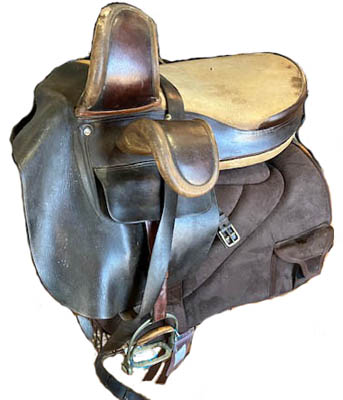
|
[Riding Style and Saddle Type] Side saddles were designed to be ridden by a woman wearing a dress and with both legs on the left side of the saddle (aside rather than astride the center of the saddle). In former times the notion of a proper lady wearing pants was considered quite scandalous and the practice only came acceptable around the turn of the century. The use of side saddles was actually socially progressive, believe it or not. In medieval times noble women were generally led by a groom when on horseback and not allowed to control their own mounts. We understand the term pommel to indicate the upward projection on the front of a Western saddle. However, the more modern form of a sidesaddle has two, set-back pommels that support the rider. When using a side saddle the rider is unable to squeeze the horse's sides with the legs and must be both skilled in and in procession of a horse schooled to the use of a side saddle. A skilled aside rider can do anything an astride rider can do. You might think that side saddles have past into total disuse but some female riders will occasionally stage exhibitions of their use. On formal mounted occasions, such as trooping of the colors, the late British Queen Elizabeth employed one.
Singeing
[Obsolete Horse Grooming] In former times, before rural electronification and electric horse clippers, particularly long hairs were removed during grooming by subjecting them to singeing, singed with an open flame from a lamp to remove them.
Single Rein Port Bit
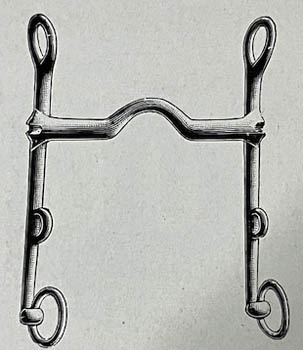
|
[Equine Equipage] A single rein port bit is a simple form of a leverage bit with a port in the mouthpiece and an attachment for an optional curb chain.
Sitting Trot
[Riding Technique] A sitting trot is when a rider does not post while the horse is trotting but remains mostly seated in the saddle. It is most easily done while a horse is in a highly collected, slow trot. Your body does still move with a slight rocking manner following the upwards and downwards rhythm with the horse. The key is to dissipate the energy imparted from the saddle without resisting it or getting out of rhythm. A horse with an energetic bounding trot can be very difficult to sit to. My basic advice is to mostly post and only do this occasionally. I am surprised to say that I really enjoy doing a sitting trot. There is something in that feeling a being in sync with the horse's motion. I was rather surprised to read on one of these rider's forums that I am not alone admitting this. Quite a few riders said the very same thing. I would not suggest trying this until you are really, really in sync with your mount.
Skewbald
[Equine Coat Coloration] Skewbald horses have a coat coloration of white patches on an other than black base coat.
Skijoring (also skijouring or skikj°ring
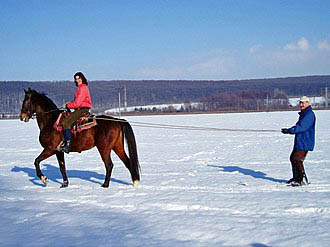
|
[Equine Sport] Skijoring is a winter sport in which an animal that need not always be a horse, pulls a skier over flat snow-covered terrain. I have never seen it in action, but it sounds interesting.
Skirts
[Saddle Terminology] The term has been used for two different parts of the saddle. The more basic use of the term is for the long leather flaps that run down the sides of the saddle that support the legs and act as a barrier protecting breeches from the horse's sweat. It can also be applied to the smaller flaps that cover the stirrup bar on the sides of the saddle. These overlap the larger skirts and are sometimes called jockeys.
Slant Load Trailer
[Horse Trailer Type] With a slant load design the horses stalls are set at a slant rather than front to back. The advantage is that more horses can be loaded in a shorter length of trailer. The dead space toward the rear is used for tack storage. Slant load trailers are wider than straight load trailers.
Sleep in Horses
[Equine Physiology] Sleep is required in mammals, birds, reptiles, amphibians and even fish. Many people are not that aware of horses sleeping and just assume they go into the barn every night for a good 8 hours rest. However, the truth is that adult horses typically get about 5 hours of sleep per day in a serries of naps, and most of it while standing up and not necessarily during the night. In any case, the majority of their sleep is at night between midnight and 4 A.M. When sleeping on cold days, they are often standing still in the field with their heads sagging and their bodies turned perpendicular to the rays of the sun. Vertebrates experience a sleep cycle, composed of four individual stages. The last stage is REM (rapid eye movement) sleep, during which dreaming occurs. REM sleep is restorative and most important to achieving a feeling of being rested. In horses REM sleep lasts about 25 minutes a day and does require that they are lying down. People seeing this for the first time often fear that the horse is dead, but they are just in deep sleep. In a herd at least one horse will remain awake and on guard. This is one reason why horses do not do well if kept alone.
Slick Fork Western Saddle
[Saddle Terminology] There are three basic design styles to western saddles' pommels: slick fork (A-fork), swell fork and the less common undercut. Then viewed from the front the fork is the arch-like bridge (pommel) that sits above the horse's spine and supports the saddle horn above it. The slick fork pommel is a more traditional design. Slick fork saddles are widest at the bottom of the pommel and narrower (less built up) as they join at the horn.
Sliding Stop
[Western Reining Competitions] A sliding stop is a maneuver in which a horse running at speed suddenly stops by planting its hind legs and sliding them across the ground and coming to a complete stop with a dramatic, dirt-throwing and crowd-pleasing slide
Slobbers
[Equine Medical Condition] The slobbers is a name given to an excessive amount of drooling.by a horse after it has eaten clover. The condition is common and fairly harmless. It is not the clover itself but the result of exposure to the compound slaframine contained in a fungus that as infested the clover.
Slobber Straps
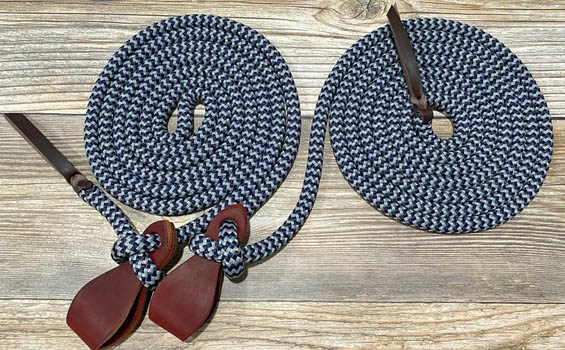
|
[Equine Equipage] The slobber straps have little to do with slobbering, but are near the horses mouth, which might account for the name. They are a short leather linkage between the bit and the reins. They are usually used with mecate reins by western riders. It is felt that they help with training, communication, and release by adding a little weight to the bit. They make for a slightly slower contact with the horse's mouth, allowing the horse to consider the next command is coming and they release more quickly reenforcing learning of the correct response to a command.
Slow Gait in American Saddlebreds
[Equine Gait Classification] The slow gait in American Saddlebreds is one of their five gaits. Historically the term was fairly non-specific as a fifth gait the horse did that did not have a uniform appearance between horses. Currently, it is more uniform and describes a four-beat stepping pace) that is different from the rack.
Snubbing (Snubbin)
[Equine Training Technique] Snubbing a horse is a training technique used in horses that resist being tied and standing still. The horse is tied to a sturdy post or large tree and forced to stand for an period of time. Often they will pull and look as if they will pull their head off. I find it hard to watch and many people feel that it is too harsh and should not be done. It does have a long history, particularly with wild horses in the west. The term is also used when controlling a young horse from a rope on its halter that is held by a near by mounted rider. In either case I feel it should only be done supervised by someone experienced in the technique.
Snaffle
[Riding Equipage] A snaffle is a non-leverage bit and one of several basic designs of bits used in horse's mouths. It consists of two rings to which the reins and the bridle headstall attach that are joined by mouthpiece that does most of the actual work. The rings may be round, oval or of a D-shape. The mouth piece maybe single- or double-jointed, multi-jointed or commonly just a solid bar. Some mouthpieces are twisted. Snaffles are the most common bit used in English riding.
Snort
[Equine Vocalization] A snort is a sudden, low-pitched, brief expulsion of air through the nose. It is generally an alarm sound. It may be heard after two unfamiliar horses confront each other. In its most benign form it is done after a horse gets something up its nose while feeding.
Sobreandando (Over Walk in Spanish)
[Equine Gait] The sobreandando is a faster, more lateral gait of the Peruvian Paso breed. A fast sobreandando can be speed of a canter in other breeds.
Society for Prevention of Cruelty to Animals (S.P.C.A.)
[Advocacy Organization] The American Society for the Prevention of Cruelty to Animals was established in 1866 to care for unwanted horses and advocate for human treatment. It was modeled on a British organization, the Royal Society for Prevention of Cruelty to Animals that had been formed in 1824. There was an attitude had one person's cruel treatment of a horse was no one else's business. It took time for a sense of social responsibility to develop and then for anticruelty laws to go on the books.
Soring
[Illegal Training Practice] Soring is the use of caustic chemicals to cause pain to the front feet and legs of gaited horses when they touch the ground, causing them to lift the legs higher and faster than they would otherwise do. This is very showy in appearance and desired in the show ring, but inflicts pain on the animal. The practice is now banned under regulations of the Horse Protection Act.
Sorraia Horse
[Equine Breed] Sorraia horses are a once wild breed native to a remote marshland in Portugal. Locals were aware of their existence, but it was not until 1920 that a zoologist Dr. Ruy d'Andrade encountered and described them. Only a small population has survived and an effort is being made to protect them from extinction. They have a dun coat coloration or of a dun variation called grullo. They also have so-called primitive markings and bicolored manes. Genetic studies are on going but some have suggested they are unrelated to other horse breeds on the Iberian Peninsula.
Sorrel
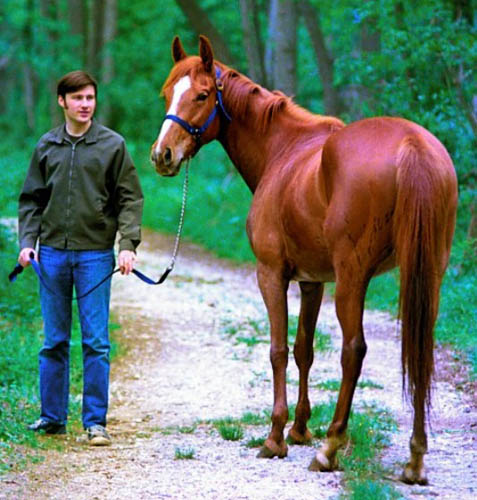
|
[Equine Coat Color] A reddish or copper-red body color to a horse's coat. It is principally caused by the presence of the recessive "ee" genotype, which inhibits the production of dark pigments. A chestnut color is darker than sorrel, but they also have a recessive "ee" of the melanocortin-1 receptor gene. The difference in shade and tone between sorrel and chestnut horses must be due to the influence of other genes and modifiers. I do not believe it is correct to say there is no genetic differences, as many do. There is no difference at the melanocortin-1 receptor gene, which is different from saying there is no genetic difference.
Sour
[Schooling] A horse is said to sour when it becomes frustrated and loses interest in working during schooling. This usually occurs when it has been schooled for too long a period of time. Horses are generally willing to please but it is as true among people as horses that sometimes enough is enough. Part of the development of a rider as a trainer of his horse is learning when to quit and to restart another day.
Spanish Riding School
[Riding Academy] The 480 year-old Spanish Riding School is not in Spain but located on Michaelerplatz Vienna, Austria in the former imperial palace, called the Hofburg. It was called the Spanish School because it featured Spanish horses and instruction in the haute Úcole style of riding popular with the Hapsburg court. In season it is possible to view demonstrations there and to take a tour. As an institution it is dedicated to the preservation of classical dressage, the breeding and very extensive training of the Lipizzaner horses. The school does occasionally take the Lipizzaners on world tours.
Spanish Walk
[Equine Movement] A Spanish walk is walk in which the horse raises each foreleg straight off the ground in an exaggerated upward and forward manner. A Spanish walk is not part of any currently used dressage test.
Spavin (Bone Spavin or Distal Tarsitis)
[Veterinary Medicine] Bone spavin is a degenerative joint disease that affects the hock joints of older horses and ponies. It presents as lameness and swelling of the hock. It is considered treatable, but often with a prolonged recovery.
Springhalt (Equine Reflex Hypertonia)
[Veterinary Medicine] Springhalt is an acquired neuromuscular condition that causes a gait abnormality, producing an involuntary, exaggerated upward movement of one or both of the hindlimbs. It is worse in cold weather. The horse is not in pain, but this can be an issue when ridden. In extreme cases it might be treated surgically, but surgery is often not successful.
Splint Bone
[Equine Anatomy] The splint bone is the name given the remnants of a horse's 2nd and 4th metacarpal (fore limb) or metatarsal (hind limb), once toes in prehistoric horses, that run down either side of the cannon bone. As a horse ages these vestigial structures tend to fuse with the cannon bone. The is a tough interosseous ligament between the structures, which through repeated injuries can become inflamed and cause a condition known as blind splints. Early stages are difficult to diagnosis in horses, who present with lameness and thus the word blind in the name. Ultrasound may show evidence of swelling from inflammation and the condition will subside with rest.
Split Reins
[Equestrian Equipage] Split reins are a pair of reins that are not jointed in the middle by a buckle and typical of sone western riding tack. The rider neck reins with one hand and has one finger between the reins to aid in making adjustments. Other western reins that are joined in the middle are called romal reins.
Spurs
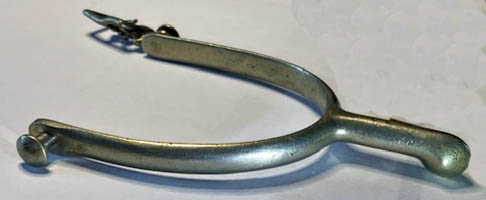
|
[Equine Equipage] Spurs are optional metal devices that strap to the heels of riding boots and reinforce a rider's leg aides. They come in several variations. The spurs make contact with the boot by a heal band, which must be sized to the boot and held in place by leather straps. Projecting off the heal band is the shank, which makes connect with the horse's side. A round wheel with teeth, called a rowel, is mounted on the tip of the shanks of some spurs. These are used by the rare English rider, but their use is typical of spurs worn by western riders. This disinclination of English riders can be traced to fox hunters, who discovered that when falling off the side of a horse the rowel can cause deep cuts. The larger western saddle protects the horse better. Riding an off-track Thoroughbred, I never felt like I needed to use spurs.
Squeal
[Equine Vocalization] A squeal is a sudden, high-pitched, sound most often made by mares. It generally occurs when two horses are in proximity (often face to face) and the squealing horse is signaling the other to back off. Often the other horse is a stranger but it can happen with horse who have been together forever. If you are mounted at the time by all means attempt to get the horses away from each other. A kick may come next. Mares in season seem disposed to squealing.
Stable Name
[Equine Appellation] A stable name is a nickname, used in place of the more formal registered name that appear on the horse's papers. There is usually a story regarding how the horse came by its nickname or sometimes it is a shortened form of the official name.
Stall
[Equine Management] A stall is a partitioned subunit of a stables to accommodate a single horse. It may have a specialty function, such as a wash stall (hose and cement floor with drains) or a foaling stall (extra large). Horses may remain in a stall and periodically put to pasture, which is referred to as being turned-out. I generally leave my stall doors open and the horses free to come and go as they please. Stalls should be designed with horse safety in mind with electric lines and lights installed out of reach and to code.
Stall Guard
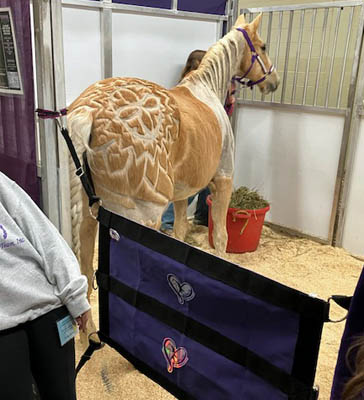
|
[Equine Management] A stall guard is a horse restraint, designed to block the entrance of a stall in place of closing the door. They are made of canvas and attach with extra strong screw eyes and clamps. They are useful if you are repeatedly entering and leaving a staff with a horse in it. You leave one side held by only the top attachment and squeeze under it. The horse, being larger, cannot follow. They also allow for more ventilation. They should be installed so that the middle of the guard meets the middle of the horse's chest. I do not like to leave a horse for a long time, unsupervised with only a stall guard. Its better to close the door. They always seem to find a way to get in themselves in trouble, as any horse owner can testify.
Stand
[Vaulting] The stand is a vaulting compulsory competition move in which the rider stands on the back of the horse all while moving.
Standardbred
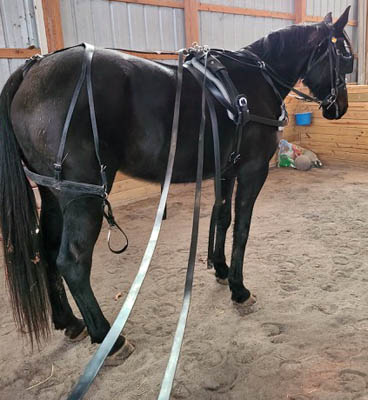
|
[Horse Breed] The Standardbred horse originated in North America, where they were used for mainly harness racing at either a trot or a pace. Despite having foundation stock consisting of Thoroughbreds, Morgans, Narragansett Pacers, Norfolk Trotters and Hackneys, they have been refined to handsome horses of a consistent appearance. Breed characteristics include having a well-muscled, long bodied build, slightly heavier than that of a Thoroughbred, solid legs and powerful shoulders and hindquarters. Current breeding practices are to breed trotters to trotters and pacers to pacers. Those horses that pace are capable of slightly higher speeds. Interestingly, some Standardbreds are capable of both trotting and pacing. Standardbred horses are now used in a variety of equestrian disciplines.
Standing Martingale
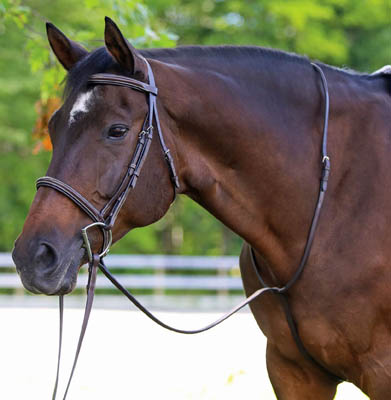
|
[Equine Equipage] A standing martingale is a optional piece of tack designed to prevent a horse from throwing its head upwards. It attaches to the girth on one end, runs between the horses legs and attaches to the noseband on the other. Supplemental straps run upwards and buckle around the neck in order to hold it flush to the horse's chest. They are generally used with English tack.
Steeplechase
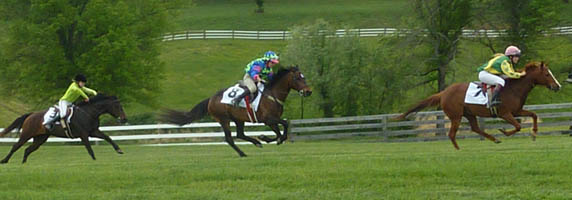
|
[Equestrian Competition] A steeplechase is a cross county race over fences and ditches. There are two forms of steeple chasing jumps: hurdle and timber. A hurdle jump is a standardized plastic and steel fence that is 52 inches tall. Timber jumps are solid, immovable wooden rail fences of different heights. Also used are brush jumps that simulate hedges. The length of the course is variable with 3-4 miles being common. Steeple chasing originated in Ireland and the word came from the fact that riders oriented on the local church steeples, the most visible landmarks on the countryside. If I have any criticisms of steeple chasing as a spectator sport, it is that you can only see the action on a limited area of the course and maybe one or two jumps. Many steeplechases are now broadcasting the entire event to television monitors placed among the spectators.
Stem Cell Therapy
[Veterinary Medicine] Equine stem cells can be injected directly into tendons or into joints to speed the healing of tendon injuries or to treat osteoarthritis (degenerative joint disease). I should mention that the term "degenerative joint disease" may misrepresent the true pathophysiology, but I will leave that to others to argue. Injuries to tendons are more serious than commonly realized. The blood supply to tendons is very limited, making healing problematic. Stem cells have proved effective and are also used in human sports injuries. I always thought of its effectiveness as near magical.
Sternal Recumbency
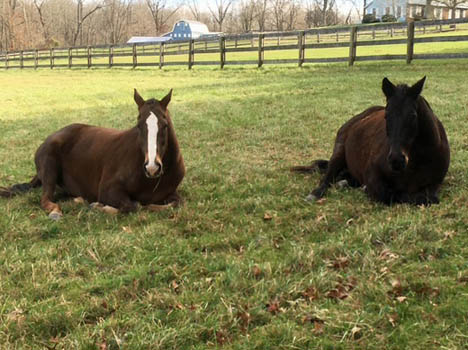
|
[Equine Position] A horse in a pose of sternal recumbency is lying on its chest and abdomen with its limbs folded. Horses often do this when sleeping or resting. The other recumbent position is flat on their sides and is called lateral recumbency.
Stifle
[Equine Anatomy] The stifle is a horse's tibio-femoral joint. It is the largest point of a horse's body and equivalent to the human's knee. It is located high on the rear leg and is under a slight fleshly bulge in the contour of the anterior part of the leg. Injury of or generative changes to the stifle is a causes of lameness in horses. There are multiple specific injuries possible in the region and determining the exact cause can be a diagnostic challenge for a veterinarian.
Stifled
[Veterinary Medicine] A stifled horse has suffered a displacement of the patella of the stifle joint, analogous to the human knee cap. Surgical management may be successful, but the prognosis is always guarded. Surgical management of congenital lateral patellar luxation carries a better prognosis.
Stirrup
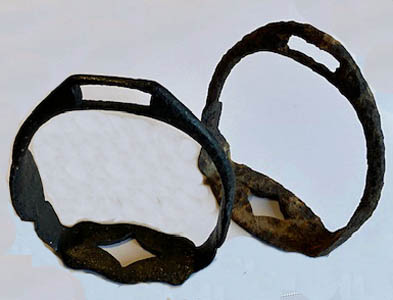
|
[Horse Equipage] A stirrup is a wooden or metal devise designed to support a rider's boots while in the saddle. It allows a ride to balance better while riding. The introduction of stirrups was a major innovation in the military applications of horses.
Stirrup Bar
[Saddle Terminology] A stirrup bar a metal fitting attached to either side of the saddle. Its purpose is to hold the top loop of the stirrup strap to the saddle. The loop is slid into position with some force as the fitting is designed to hold the loop tightly, but also to permit the removal of the strap for cleaning and other needs.
Stirrup Cup
[Fox Chasing] The stirrup cup is a drink of port or sherry traditionally served to the mounted hunters as they wait to set off. It is offered up from a tray by a helper circulating on the ground.
Stirrup Strap (Stirrup Leathers)

|
[Horse Equipage] A heavy duty strap, generally of leather, that connects the stirrups to the saddle bar. They are adjustable to a rider's leg length and the seat desired for the particular equine activity being performed, using a buckle and holes along the other end of the strap. The straps are often referred to as "leathers." A general rule is to initially adjust the length of the straps to be the same as the distance between the rider's arm pit and the end of the arm. This might then be then adjusted according to the rider's comfort. I feel if my leathers are too long or short for my comfort. Jockeys ride in extremely short stirrups, while dressage riders often ride with long stirrups and little flexion to the knees.
Stocked Up
[Veterinary Medicine] A horse that is stocked up has an accumulation of lymphatic fluid, manifested as slight swelling in the lower legs. It tends of occur as a result of an injury or simply from being confined to a stall. Exercise tends to clear it.
Stock Seat
[Western Riding Saddle Posture] A western rider rides with a stock seat in the saddle. The rider has their weight sunk into their seat and distributed through their legs while on the western saddle, which is constructed in a way that allows the weight of the rider to be spread over a larger area of the horse's back. The stirrups are set long and with rider is totally upright and balanced, using an elevated non-dominate hand to neck rein the horse. There is a big difference in seat posture used in western riding and those used in typical English riding.
Stock Tie
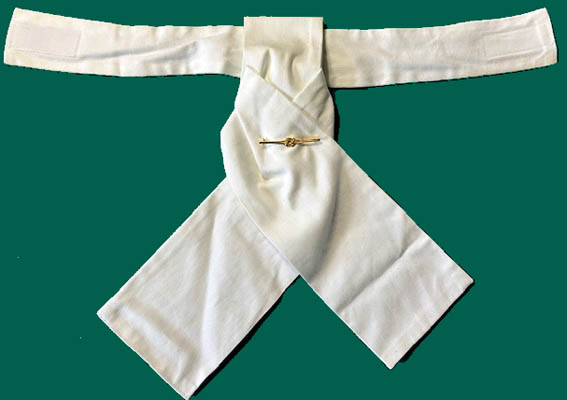
|
[Fox Chasing and Showing] A stock tie is a white tie worn in formal fox chasing and formal wear during showing. For lazy riders, like myself they can be purchased pretied with a Velcro attachment in the back. They are held in place by a pin.
Stock Trailer
[Trailering] A stock trailer is one designed with open sides rather than a solid wall with widows. Some are equipped with sliding panels that can be slid into place closing the trailer up in bad weather. Larger low-roofed stock trailers should be used for other live stock and not horses since they do not have adequate head room.
Stone Bruise
[Veterinary Medicine] Stone bruises occur when a horse either picks up or more commonly steps on a stone in such a way to injure the structures of the bottom of the hoof. Inspection of the hoof may reveal an obvious bruise. It is a cause of lameness but generally resolves with removal of the stone with a hoof pick if one is still in place or supportive care and rest if it is not. Prevention is basically trying to keep horses off of rocky areas. I will toss used saw dust bedding on areas of rocky ground they must walk over for what it is worth.
Straight Stall
[Equine housing] A straight stall is a rectangular compartment in a barn or stables to house a horse and is generally too narrow for them to turn around. It may be used on a more temporary basis than the larger box stall that permits more freedom of movement. Horses do get bored when confined too long.
Streptococcus equi zooepidemicus
[Veterinary Medicine] Streptococcus equi zooepidemicus is a bacterial organism that is normal flora in the horse's upper airway. However, it can reach to lower airway and become an opportunistic pathogen, leading to pneumonia. Fortunately, it is still highly susceptible to Penicillin, as well as Ampicillin and Erythromycin. Very rarely, it is a zoonotic pathogen in humans. Among those are the occasional human that has experienced an enthusiasm for raw milk. Take it from me, Pasteurization really is a good idea.
Stride
[Equine Locomotion] A stride is the distance covered during a cycle of motion beginning and ending at the same point in the movement. For example, the famous race horse Secretariat was calculated to have an average stride length of 23.8 feet (7.27 meters). When riders evaluate a jumping course they walk the course and count the strides needed to cover the distance between obstacles (known as seeing the stride). About four human strides equal one horse canter stride.
Stringhalt (Equine Reflex Hypertonia)
[Veterinary Medicine] Stringhalt is a neuromuscular condition that causes muscle spasms in which a horse's hindlimbs flex upwards. The abnormally may affect one leg or both and the severity varies. The cause of stringhalt is mostly unknown, but a form of it, common in Australia, comes from eating toxic plants. The condition is mostly not responsive to treatment and I would not advise riding a horse with stringhalt.
Strongyles (Blood Worms)
[Veterinary Medicine] Strongyles are an order of parasitic nematode worms that infests horses and other grazing animals. They then live in the gastrointestinal tract and can cause anemia.
Stud Chain (Stallion Chain - British Usage)

|
[Horse Management] A Stud chain is a length of chain set between the snap and leather or nylon lead that is held by a handler. The chain is feed through rings on the halter and run over the horse's nose to provide pressure and more control. Such an arrangement is often used on stallions, but with serve with any horse that is subject to getting excitable.
Suffolk Punch Draft Horse (Suffolk Draft Horse)
[Equine Breed] Suffolk Punch draft horse is native to the county of Suffolk United Kingdom and is a relatively short but powerfully built draft. A more compact draft actually expends less traction energy than a taller animal and is more efficient.
Sulky
[Horse Racing] A sulky is a light two wheeled, one horse conveyance used in harness racing.
Superfecta
[Horse Racing] A type of betting in which the bettor must pick the 1st, 2nd, 3rd and 4th place winners, in order of their finish. Needless to say the odds of doing this are huge, but I am grateful for the bettors donation to the horse racing industry.
Suppleness
[Equine Quality] Suppleness reference to the degree of flexibility and fluidity in a given horse's movements. It can be enhanced by exercise and training. Among humans you might observe suppleness in practitioners of yoga or dancers.
Suprascapular Neuropathy of the Shoulder (Sweeney Shoulder)
[Veterinary Medicine] Suprascapular neuropathy of the shoulder is an atrophy of the infraspinatus and triceps muscles, caused by damage to the suprascapular nerve. In former times this was common in improperly harnessed horses. It appears as a hollowed area just below and to the rear of the horse's shoulder line.
Surcingle (Overgirth)
[Equine Equipage] A surcingle is strap, usually made of leather, that that fastens completely around a horse's girth. There are several different types of surcingles depending on the purposes for which they are employed. Surcingles are used for securing packs on pack animals, in schooling with long reins, in vaulting and it also is a component of harnesses.
Suspensory Ligament
[Equine Anatomy] The suspensory ligament is a band of tissue on the the fore and hindlegs that supports the fetlock joint and prevents it from dropping low. It incorporates several sesamoid bones. Suspensory ligament injuries (desmitis or sprains) are common in athletic horses.
Swan Neck
[Conformation Fault] A swan necked horse has a too long and thin neck that curves like a swan.
Skewbald
[Horse Color Pattern] Skewbald coloration is a term mostly used in the United Kingdom now for those horses that have white mixed other areas of color other than black, while in the U.S. this pattern is commonly called a pinto. The British in contradistinction use the term piebald for horses that have a black and white coloration.
Swayback (Equine Lordosis, also Hallow Back or Dipped Back- British usages)
[Veterinary Medicine] A horse that has a swayback has a concavity to the line of the spine beginning behind the withers. The impression is that the horse is sagging. It is associated with aging and appears in some breeds, such as American Saddlebreds, more that others. The condition is generally believed not to be painful. However, there is a loss of muscle tone and weakened supporting structures that should be respected in riding the animal. A major issue with riding a swayback is fitting a saddle to conform to the back alignment. Consulting a saddle fitter is a good idea. Burden should be restricted and massage and conditioning exercises are helpful.
Sweat Scraper

|
[Grooming Tool] A sweat scraper is a tool used to removed excess water or sweat from a horse's coat. When a horse is worked in hot weather or has sweated under a saddle the sweaty areas can be sponged and the excess water removed with the scraper. This is also a good way to remove the dirt build up that commonly occurs around the edges of the saddle pad. You particularly want to do this if the horse is about to be loaded in a trailer and cannot dry naturally in the sun. There are various types available on the market.
Swedish Oxer Jump
[Jumping] Swedish oxers consist of a group of two to four jumps set to be jumped together. The rails are tilted with the crossed set of rails appearing like an X in the middle.
Swedish Warm Blood
[Equine Breed] Swedish Warm Bloods are a breed developed in Sweden. The breed was established in the seventeenth century as part of a program to produce military mounts. In modern times they are used as general purpose riding horses and sport horses and.have been found to make good dressage horses as well.
Sweeney Shoulder (Suprascapular Neuropathy of the Shoulder)
[Veterinary Medicine] A Sweeney shoulder describes an atrophy of the infraspinatus and triceps muscles, caused by damage to the suprascapular nerve. In former times this was common in improperly harnessed horses. It appears as a hollowed area just below and to the rear of the horse's shoulder line. You wonder just where these odd names, like Sweeney, came from?
Sweet Itch
[Veterinary Medicine] Sweet itch is an allergic reaction to biting insects. It causes severe itching, hair loss and weeping sores. The mane, base of the tail, withers, face, and ears seem to be effected preferentially. Insect control measures and covering the effected areas can help.
Swell Fork Western Saddle
[Saddle Terminology] There are three basic design styles to western saddles' pommels: slick fork (A-fork), swell fork and the less common undercut. Then viewed from the front the fork is the arch-like bridge (pommel) that sits above the horse's spine and supports the saddle horn above it. Swell fork as compared to slick fork saddles are widest across the middle of the fork and also wider (more built up) as they join at the bottom of the horn. In this way they give a little extra support to the rider.
Swells
[Saddle Terminology] The swells of certain western saddles are a wider (more built up) area located were they join at the bottom of the horn. In this way they provide a little extra support to the rider.
Swingle Bar (Swingletree)
[Driving Equipage] A swingle bars is a horizontal bar attached to the front of the carriage that distributes the pulling force evenly between multiple horses and acts as a balancing point for the load. The traces attach to the swingle bar and the swingle bar to the vehicle.